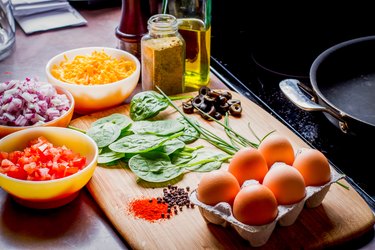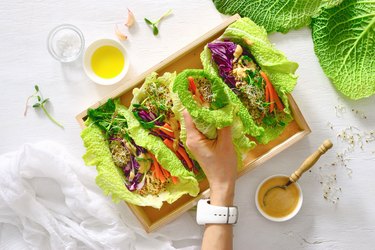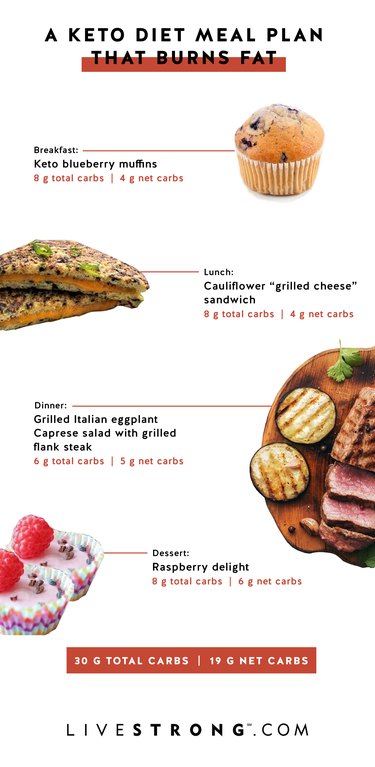
Now that the ketogenic diet (or "keto" for short) has been around the diet track a few times, you may have mustered up the courage to try it. Or maybe you're giving it a second go-around.
Either way, meal planning is key to sticking to this high-fat, moderate-protein, super-low-carb diet.
Video of the Day
Video of the Day
In fact, a June 2020 study in The American Journal of Medicine notes that this diet is not for people who aren't meticulous and driven to make the right food choices — so make sure to plan ahead with our keto grocery list and weeklong meal plan.
Warning
People with pancreatic, thyroid, liver or gallbladder issues, or those with a history of eating disorders should not try the keto diet, according to the Academy of Nutrition and Dietetics. Speak to your doctor or a registered dietitian to make sure the keto diet is right for you.
How to Meal Plan for the Keto Diet
Below is the typical macronutrient breakdown on the keto diet. You should aim to get:
- 5 to 10 percent of your total calories from carbs
- 20 to 25 percent of your total calories from protein
- 70 to 80 percent of your total calories from dietary fat
Because your body turns to stored fat for energy instead of its preference — carbs — cutting carbs and adding fat is the secret sauce that makes this diet work.
If you start the keto diet cold turkey and fail to plan, you might reach for any snack in sight when hunger hits. The result? You may get kicked out of ketosis, the state in which your body burns fat instead of carbs for fuel. That's where meal planning comes in.
Your first step in ensuring your journey on the keto diet is a successful one involves understanding which foods are allowed and which foods you should avoid (so study our grocery list below diligently!).
Because you probably don't have all of the keto-friendly foods you need just hanging out around the house, you'll need to go grocery shopping and plan your meals in advance.
Related Reading
Keto Diet Grocery List
Keto-Friendly Foods
- Eggs
- Meats: chicken, beef, fatty fish, pork
- Full-fat, grass-fed dairy: plain yogurt, butter, cheese, sour cream, cottage cheese
- Avocado
- Oils: olive, canola, flaxseed, avocado, coconut
- Olives and pickles
- Berries
- Nuts and nut butter
- Flaxseeds and chia seeds
- Non-starchy vegetables: mushrooms, zucchini, spinach, leafy greens, celery, cruciferous veggies
Keto-Friendly Drinks
- Water
- Unsweetened tea
- Black coffee
- Bulletproof coffee
Foods to Limit on Keto
- Most fruits: bananas, apples, oranges, mangoes, papaya, pineapple
- Starchy vegetables: white potatoes, sweet potatoes, yams, peas, corn, parsnips
- Beans and legumes
- Grains: bread, cereals, bagels, rice, oats and oatmeal, quinoa, buckwheat, amaranth, barley
- Sugar and sugary beverages
Related Reading
How to Get More Fiber on Keto
Here's the deal, though: You can't just eat bacon and butter all day long. Why? You'll likely end up with some significant nutrient deficiencies, not to mention digestive woes.
While you'll want to pay attention to your total carb count, you should also aim to get as much fiber as you can. Fiber is a carb that goes undigested, so it doesn't affect your blood sugar. You should aim to get 14 grams of fiber for every 1,000 calories you eat per day, per the Academy of Nutrition and Dietetics.
Understanding the difference between net and total carbs can help here. Your total carb count includes fiber, sugar and starch in a food. Net carbs are the grams of carbs coming just from sugar and starch. Subtract fiber from total carbs to calculate your net carb amount.
Considering keto focuses mainly on fat and shuns carby foods, it can be hard to get enough fiber in. But incorporating enough non-starchy veggies and low-sugar fruits will help you hit your fiber goals.
Choosing Healthy Fats
Use non-starchy vegetables as vehicles for healthy fats.
"Roast vegetables like broccoli, cauliflower and asparagus in batches, then top with generous amounts of olive or avocado oil," Shannan Bergtholdt, RDN and founder of Revolution Dietitian, tells LIVESTRONG.com. "Add the roasted vegetables into an egg scramble or pair with lean proteins at meals throughout the week."
You'll have to be picky about your oils, too. "Oils that are highest in omega-3 and omega-9 fatty acids are your healthiest choices," says Jean LaMantia, RD. "These include olive, canola, avocado, flax, hazelnut oils as well as sunflower and safflower oils that are labeled 'high oleic.' Oils to limit include corn, grapeseed, sunflower and safflower (that aren't labeled high oleic) and cottonseed oil."
When you're buying packaged foods, check the ingredient lists to make sure your product contains these better-for-you oils.
Tip
If you're reaching for nuts to snack on, note that nuts and nut butters have carbs, so be careful not to go overboard. However, they do provide you with much-needed fiber.
Your 7-Day Keto Diet Meal Plan

Monday
- Breakfast: Simple Southwestern Egg Scramble (3 grams total carbs)
- Lunch: Tangy Tuna Salad in Collard Wrap (23 grams total carbs)
- Dinner: Creamy Tequila Lime Chicken, Pepper and "Fettucine" Skillet (13 grams total carbs)
- Snacks: Guacamole (made with 1/2 avocado) with 1 cup of sliced radishes (10 grams total carbs)
Total carb count for the day: 49 grams
Tuesday
- Breakfast: Middle Eastern Savory Yogurt Jar (17 grams total carbs)
- Lunch: Cauliflower "Grilled Cheese" Sandwich (8 grams total carbs)
- Dinner: Grilled Curry Chicken Thighs on Wilted Greens (8 grams total carbs)
- Snacks: 1 ounce of beef jerky and a cheese stick (1 gram total carbs)
Total carb count for the day: 34 grams
Wednesday
- Breakfast: Keto Blueberry Muffins (8 grams total carbs)
- Lunch: Keto Chicken Enchiladas (14 grams total carbs)
- Dinner: Cauliflower "Fried Rice" Entrée (18 grams total carbs)
- Snacks: 5 ounces of full-fat cottage cheese (5 grams total carbs)
Total carb count for the day: 45 grams
Thursday
- Breakfast: Tex Mex Vegan Breakfast Hash (20 grams total carbs)
- Lunch: Keto Tortilla Soup (14 grams total carbs)
- Dinner: Chili-Lime Turkey Tacos with Monterey Jack Shells (7 grams total carbs)
- Snacks: 1 ounce of walnuts and 1 cup of raspberries (8 grams total carbs)
Total carb count for the day: 49 grams
Friday
- Breakfast: Rocket Fuel Chocolate Breakfast Smoothie (14 grams total carbs)
- Lunch: Heirloom Tomato, Avocado and Goat Cheese Plate with grilled chicken (20 grams total carbs)
- Dinner: Chicken Sausage and Zucchini Hash (11 grams total carbs)
- Snacks: 1 cup of zucchini noodles with 1 tablespoon olive oil and salt and pepper (3 grams total carbs)
Total carb count for the day: 48 grams
Saturday
- Breakfast: Mesclun Egg Salad (20 grams total carbs)
- Lunch: Keto Carnitas Salad (5 grams total carbs)
- Dinner: Grilled Italian Eggplant Caprese Salad with grilled flank steak (6 grams total carbs)
- Snacks: Eight 3-inch-long celery sticks with 2 tablespoons of cream cheese (7 grams total carbs)
Total carb count for the day: 38 grams
Sunday
- Breakfast: Sun-Dried Tomato Bacon Frittata With Garlic Aioli (3 grams total carbs)
- Lunch: Spicy Shrimp Fajitas (17 grams total carbs)
- Dinner: Grilled chicken thighs and Pan-Roasted Broccoli With Tahini Dressing (11 grams total carbs)
- Snacks: Raspberry Delight (8 grams total carbs)
Total carb count for the day: 39 grams
Things to Keep in Mind Before Going Keto
- Give yourself time to adjust to this diet. Feeling sick soon after starting the diet is normal and referred to as the "keto flu." This usually goes away after a few days, but it can be understandably worrisome. If your symptoms persist, consider speaking to your doctor or dietitian.
- Track your macros with an app. If you're worried about staying on track and keeping your nutrition in check, it might be helpful to get a keto-friendly diet app such as MyPlate to make sure you're hitting your macro goals.
- The keto diet isn't very restaurant-friendly. Be prepared to pack your own food with you and let your friends and family know about your new diet to avoid feeling out of place when you need a bite.
- It can be expensive. Although keto is a fat-heavy diet, it's also higher in animal proteins — and that means shelling out more money at the grocery store. Buy in bulk when you can to save some cash.
